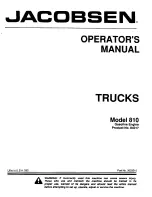
Clutches
Clutch Operation
Applying the Clutch Brake
The purpose of the clutch brake is to stop the trans-
mission gears from rotating in order to engage the
transmission gears quickly in making an initial start.
To apply the clutch brake, put the transmission in
neutral and press the clutch pedal to the floor.
CAUTION
Never apply the clutch brake while the vehicle is
moving. The clutch pedal should never be
pressed down fully before putting the transmis-
sion in neutral. Considerable heat will be gener-
ated, which will be detrimental to the friction
discs, release bearings, and transmission front
bearings.
Applying the clutch brake with the transmission still in
gear puts a reverse load on the gear. At the same
time, it will have the effect of trying to stop or decel-
erate the vehicle with the clutch brake. Rapid wear of
friction discs will take place necessitating frequent re-
placement.
Vehicle Overload, or Overloading the
Clutch
CAUTION
Overloading will not only result in damage to the
clutch, but also to the entire powertrain.
Clutches are designed for specific vehicle applica-
tions and loads. These limitations should not be ex-
ceeded.
Riding the Clutch Pedal
Riding the clutch pedal is destructive to the clutch.
Partial clutch engagement permits slippage, and gen-
erates excessive heat. Riding the clutch pedal will
also put a constant thrust load on the release bear-
ing, which can thin out the lubricant. Release bearing
failures can be attributed to this type of misuse.
Holding the Vehicle on an Incline With a
Slipping Clutch
A slipping clutch accumulates heat faster than it can
be dissipated, resulting in early clutch failures. Never
use the clutch to hold a vehicle on a hill.
Coasting With the Clutch Released
(pedal down) and the Transmission in
Gear
WARNING
Do not coast with the clutch released (pedal de-
pressed) and the transmission in gear. High
driven-disc rpm could cause the clutch facing to
be thrown off the disc. Flying debris could cause
injury to persons in the cab.
If the transmission remains in a low gear and the ve-
hicle gains speed, as may occur on a downgrade,
the input shaft and clutch driven disc will turn at
speeds that are higher than normal. This occurs be-
cause the rear wheels and the driveline become the
input for the transmission, and a higher-than-normal
speed for a given transmission gear translates to a
higher rpm value for the clutch driven disc.
Clutch driven discs are designed to allow for some
amount of excess rotational speed, but the facing
has a limited burst strength. If the clutch driven disc
rpm increases too much, the clutch facing can be
thrown off the disc(s).
Engaging the Clutch While Coasting
Engaging the clutch while coasting can result in tre-
mendous shock loads and possible damage to the
clutch as well as to the entire drivetrain.
Report Erratic Clutch Operation Promptly
Reporting erratic clutch operation as soon as pos-
sible will give maintenance personnel a chance to
inspect the clutch components.
CAUTION
Operating the vehicle with incorrect clutch pedal
free-travel could result in clutch damage. See
Group 25 of the
Business Class
®
M2 Workshop
Manual
for free-pedal adjustment procedures and
specifications.
Drivetrain
8.1




























